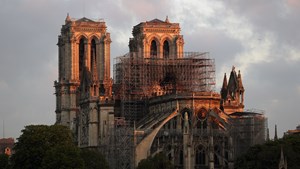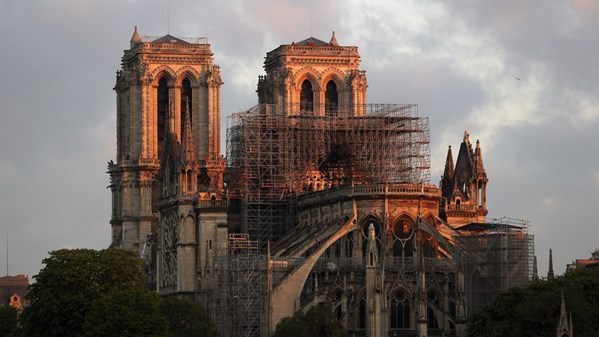
An environmental group has filed a lawsuit alleging that lead pollution from the April 15 fire that destroyed the spire and damaged the roof of Paris’s Notre-Dame cathedral is endangering the health of nearby residents.
Image courtesy to Architectural Digest
The Robin des Bois organisation, an environmental NGO, has been sounding the alarm about elevated lead levels for weeks now, according to a report in Le Monde newspaper. On July 26 the group backed up its warnings with action by filing a lawsuit in Paris accusing French authorities of “wrongful failure”.

Image courtesy to Architectural Digest
The action came a day after two nearby schools were closed over lead contamination fears and restauration work at the landmark was halted to protect workers from being exposed to hazardous levels of the metal.
But organisations allege that authorities have been covering up the danger posed by the fire that ravaged the spire and roof of the cathedral, and of the subsequent restauration work.
Environmental groups warned soon after the disaster that as many as 400 tonnes of lead in the historic church's roof had gone up in flames, later settling as dust on and around the site, endangering the health of people who live and work nearby.
Last week authorities insisted that lead contamination from the blaze posed no danger, following a media report alleging that they had covered up pollution levels in local schools.
But the top government official in the Paris region ordered work on the gutted monument to stop Thursday, saying that anti-contamination measures were not tight enough and "not being sufficiently applied".
Prefect Michel Cadot told reporters that the site at the heart of the French capital could be closed for up to a week until new safety measures are put in place.
He said that even though health and safety inspectors gave prior warning about their visits, they found safety rules were not being "systematically applied".
Cadot said strict controls should have been in place in the heavily contaminated interior of the cathedral, as well as the exits and surrounding area, which has been sealed off since the fire.
Inhaling or ingesting lead can lead to a range of health problems, including damage to the nervous and reproductive system, with children particularly vulnerable.
In its complaint, Robin des Bois accuses authorities of deliberately endangering people and of “failure to assist a person in danger”, Le Monde reported. The shortcomings lie both in the implementation of protective measures and in communicating the potential dangers to workers on the site and to nearby residents.
"In three months, we have accumulated enough evidence of the inertia of the public authorities to decide to take legal action," Jacky Bonnemains, President of Robin des Bois told Le Monde.
While authorities insist they have taken appropriate measures and been fully transparent, instructions as to how to avoid lead contamination were not distributed to residents until two weeks after the fire and a map showing lead levels – which are highly elevated in some areas – was not made public until July 18.
'Precautionary measure'
Paris city hall closed a nursery and primary school – which were jointly hosting a holiday club for 180 children in Paris's 6th district – "as a precautionary measure" after tests revealed high levels of lead in their shared playground, a municipal spokesperson told AFP.
Officials ordered a "deep clean" of schools near Notre-Dame last week, with walls and furniture to be wiped and playgrounds hosed down over the summer holidays.
French investigative website Mediapart said that high levels of lead had been detected in schools and crèches surrounding Notre-Dame.
Mediapart said that the authorities had waited until a month after the fire before conducting tests in the 10 crèches and schools that are within 500 metres of the monument on the Île de la Cité island in central Paris.
One test result – in the private Sainte-Catherine primary school – showed 698 microgrammes of lead per square metre, nearly 10 times higher than the 70-microgramme level considered potentially dangerous, it said.
Paris health official Arnaud Gauthier said Thursday that the cleanup was "to reassure that the risk is minimal", although Deputy Paris Mayor Emmanuel Gregoire insisted it was normal procedure and nothing to do with the fire or lead contamination.
Cadot said that "all precautions must be taken" at the cathedral itself to protect workers shoring up the gutted 850-year-old building, which is still in danger of collapse.
He urged tighter safety regulations and expanded decontamination facilities.

ArtDependence Magazine is an international magazine covering all spheres of contemporary art, as well as modern and classical art.
ArtDependence features the latest art news, highlighting interviews with today’s most influential artists, galleries, curators, collectors, fair directors and individuals at the axis of the arts.
The magazine also covers series of articles and reviews on critical art events, new publications and other foremost happenings in the art world.
If you would like to submit events or editorial content to ArtDependence Magazine, please feel free to reach the magazine via the contact page.